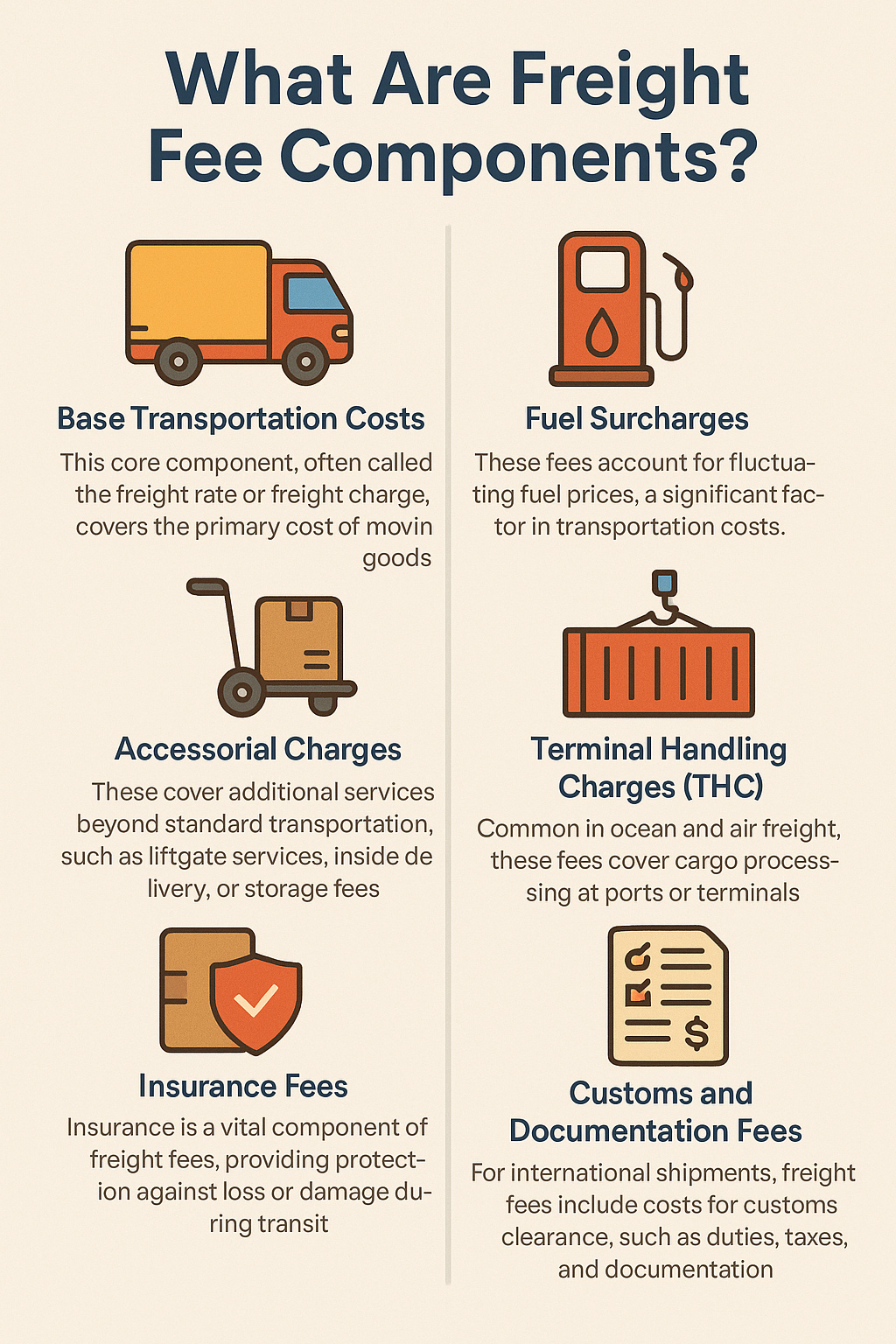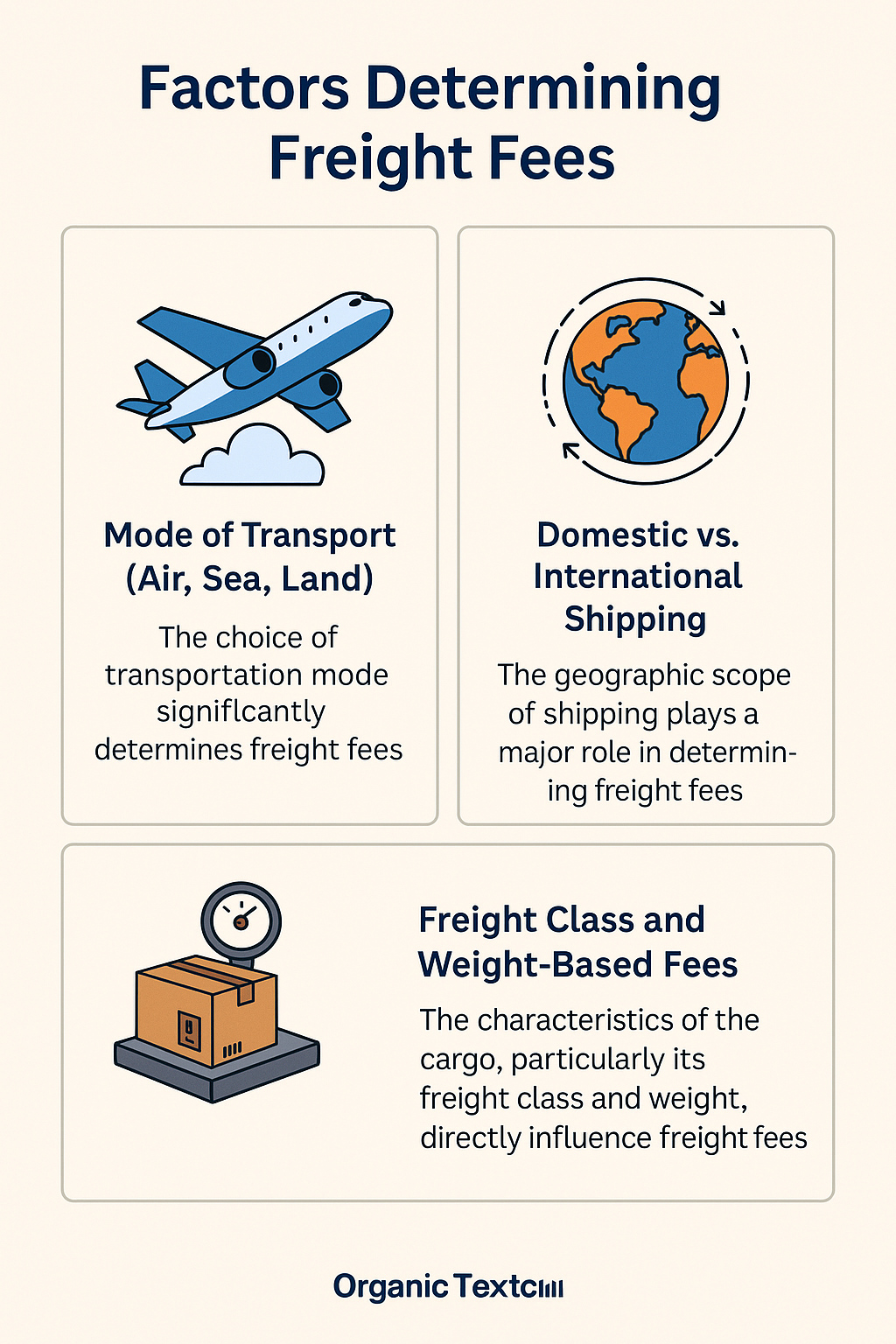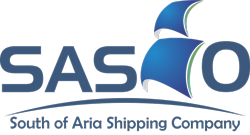What Is Freight Fee?
The “freight fee” is a critical component of logistics costs, encompassing basic transportation rates, fuel surcharges, and additional services such as handling or insurance. It directly influences the overall cost of shipping.
To fully understand what is freight fee, it’s important to distinguish it from related terms. For example, “freight charges” generally refer to a broader range of expenses, including customs clearance, warehousing, and handling fees. In contrast, “shipping costs” is a more comprehensive term that includes all expenses involved in delivering goods—such as freight fees, packaging, duties, and last-mile delivery (the final step of transporting goods to their destination). In essence, the freight fee is just one part of the total shipping cost.
|
Term |
Definition |
Includes |
Scope |
|
Freight Fee |
The basic cost of transporting goods from one point to another |
Transportation rates, fuel surcharges, handling, insurance |
A part of shipping |
|
Freight Charges |
A broader set of costs related to moving freight |
Freight fee, customs clearance, warehousing, handling fees |
Broader than freight fee |
|
Shipping Costs |
The total cost of delivering goods to the final destination |
Freight charges, packaging, duties, last-mile delivery |
Most comprehensive |
What Are Freight Fee Components?
It represents the total cost of transporting goods from one location to another, encompassing various charges that reflect the complexity of logistics operations. Understanding these components is essential for businesses to manage shipping expenses effectively. Below is a detailed breakdown of the key elements that make up freight fees, ensuring clarity on what freight fee is and its role in logistics:
- Base Transportation Costs: This core component, often called the freight rate or freight charge, covers the primary cost of moving goods. It depends on factors like transportation mode (truck, ship, air, or rail), shipment weight, volume, and distance. For example, ocean freight rates are typically lower than air freight due to higher cargo capacity, but they vary by route and market demand.
- Fuel Surcharges: These fees account for fluctuating fuel prices, a significant factor in transportation costs. What is freight fee without considering fuel costs? Fuel surcharges are often a percentage of the base rate or calculated per mile for truckload shipments. In ocean freight, a Bunker Adjustment Factor (BAF) adjusts for fuel price changes.
- Accessorial Charges: These cover additional services beyond standard transportation, such as liftgate services, inside delivery, or storage fees. Examples include demurrage for delays in loading/unloading and container cleaning fees. These charges are critical to understanding what freight fee is, as they can significantly increase the total cost if not planned for.
- Insurance Fees: Insurance is a vital component of freight fees, providing protection against loss or damage during transit. This fee, often optional but highly recommended, varies based on the cargo’s value and risk level. Including insurance ensures businesses are safeguarded, making it a key part of the freight fee structure.
- Terminal Handling Charges (THC): Common in ocean and air freight, these fees cover cargo processing at ports or terminals, including loading, unloading, and storage. THC varies by port and can be optimized through efficient scheduling.
- Specialized Service Fees: Shipments involving hazardous materials, oversized cargo, or refrigerated goods incur extra charges. For instance, a Heavy Lift (HEA) surcharge applies to heavy cargo, while a Special Equipment Surcharge (SPE) covers refrigerated containers.
By dissecting these components, businesses gain a clearer picture of what is freight fee, enabling better budgeting and cost optimization in logistics operations.

Factors Determining Freight Fees
Below, we explore the key factors that influence freight fees, providing clarity on what freight fee calculations entail and how they impact logistics operations.
- Mode of Transport (Air, Sea, Land)
The choice of transportation mode significantly determines freight fees. Air freight fees are higher due to speed and limited cargo space, calculated based on chargeable weight (actual or dimensional). Sea freight fees, such as Full Container Load (FCL) or Less than Container Load (LCL), are typically lower per unit but include additional charges like Bunker Adjustment Factor (BAF) for fuel or Terminal Handling Charges (THC). Land freight (truck or rail) fees depend on distance and load type, with truckload (TL) or less-than-truckload (LTL) pricing. Each mode’s unique cost drivers, such as fuel efficiency for land or port fees for sea, shape the overall freight fee.
- Domestic vs. International Shipping
The geographic scope of shipping plays a major role in determining freight fees. Domestic shipping fees are generally simpler, driven by base transportation costs, fuel surcharges, and accessorial charges like delivery fees, with fewer regulatory requirements. International shipping fees are more complex, as they include customs duties, taxes, and documentation costs (e.g., Air Waybill or Bill of Lading). Additional fees, such as Importer Security Filing (ISF) or Currency Adjustment Factor (CAF), further increase costs. Understanding what freight fee entails in domestic versus international contexts helps businesses anticipate and manage these variations.
- Freight Class and Weight-Based Fees
The characteristics of the cargo, particularly its freight class and weight, directly influence freight fees. Freight class, used primarily in less-than-truckload (LTL) shipping, is determined by the National Motor Freight Classification (NMFC), which considers density, stowability, handling, and liability. Classes range from 50 (dense, low-value items) to 500 (light, high-value items), with higher classes resulting in higher fees. Weight-based fees apply across all transport modes, where heavier or bulkier shipments increase costs. For example, air freight uses chargeable weight, while sea freight may charge per container or weight tier. These factors ensure freight fees reflect the resources required for transport.
By understanding these factors, businesses gain a clearer picture of what is freight fee calculation, enabling better budgeting, carrier negotiations, and cost optimization in logistics operations.

How to Calculate Freight Fees
Beyond understanding what is freight fee, knowing how it is calculated is crucial for businesses to streamline logistics costs. Below are three effective methods for calculating freight fees.
Manual Calculation Based on Common Pricing Models
- Per Mile Pricing:
In land transport (truck or rail), freight fees are often based on distance. For truckload (TL) shipments, a fixed rate per mile or kilometer applies. For less-than-truckload (LTL), costs depend on distance, weight, and freight class.
- Formula: Cost = Rate per Mile × Distance
- Example: A rate of $2 per mile for a 500-mile trip yields a cost of $1000.
- Per Kilogram Pricing:
In air and sea transport, what is freight fee often hinges on weight—either actual or dimensional (calculated as length × width × height / dimensional factor, typically 6000 for air). The higher of the two weights is used as the chargeable weight.
- Example: For a shipment with 100 kg actual weight and 120 kg dimensional weight, at $5 per kg, the cost is 120 × 5 = $600.
- In sea freight, costs may be per container (FCL) or based on weight/volume for LCL shipments.
- Accessorial Charges:
Additional fees, such as fuel surcharges, port charges (e.g., Terminal Handling Charges), or documentation fees (e.g., Air Waybill), are added to the base rate. These charges are critical to understanding what is freight fee in the total cost.
Tools and Software for Estimation
- Online Freight Calculators:
Platforms like Freightos, Flexport, and C.H. Robinson offers tools to estimate freight fees. Users input origin, destination, weight, dimensions, and transport mode (air, sea, or land) to receive instant quotes. For example, Freightos provides real-time rates for LCL sea shipments. - Logistics Software:
Transportation Management Systems (TMS) like SAP Transportation Management or Oracle Logistics calculate fees by analyzing market rates and historical data. These tools ensure precise estimates for complex shipments. - Carrier Quote Tools:
Many carriers, such as DHL, FedEx, or Maersk, provide online tools for instant quotes. Entering shipment details yields accurate rate estimates tailored to specific routes.
Negotiating with Carriers
Choosing a reliable freight forwarder is crucial for reducing freight fees. Compare rates from multiple carriers to identify competitive offers. Leverage high shipment volumes or regular shipping schedules to secure discounts. Ensure transparency in shipment details (weight, dimensions, and timing) to avoid unexpected costs and streamline negotiations. A well-selected carrier can significantly lower overall expenses while maintaining service quality.
Strategies to Optimize Freight Costs
To effectively manage logistics expenses, businesses must adopt these strategies:
- Shipment Consolidation: Combining smaller loads into a single shipment reduces per-unit costs. This method is especially effective for Less than Container Load (LCL) sea transport or Less than Truckload (LTL) land transport, helping businesses save significantly on what is freight fee in these contexts.
- Cost-Effective Transport Modes: Choosing sea transport over air for non-urgent shipments or rail for regional routes can lower expenses. By aligning transport mode with delivery timelines and distance, businesses can minimize freight fees while maintaining reliability.
- Collaboration with Freight Brokers: Partnering with experienced freight brokers, particularly in regions like Asia and the Middle East, leverages local market knowledge to secure competitive rates. For example, companies like SASCO, specializing in shipments from Iran to Persian Gulf countries and CIS nations, offer cost-effective solutions through their regional expertise. Negotiating with such brokers ensures cost savings and operational efficiency.
By strategically applying these methods, businesses can reduce freight fee and achieve seamless, cost-efficient logistics operations.







